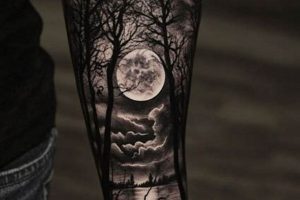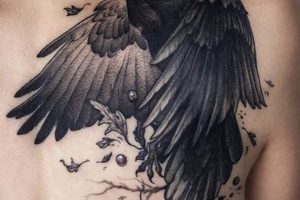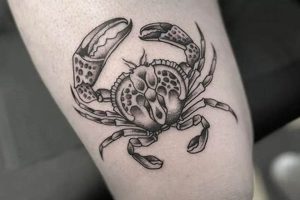Transforming unwanted ink into fresh artwork is a growing practice in the tattoo industry. This involves concealing a previous tattoo, whether due to dissatisfaction with the original design, changes in personal aesthetics, or the desire for a more polished piece. Examples range from incorporating elements of the old tattoo into a new design to completely obscuring it with a larger, more intricate piece.
The practice offers a meaningful solution for individuals seeking to reclaim their body art. Rectifying a past tattoo choice can provide significant emotional relief and boost self-confidence. This approach also contributes to the evolution of tattoo artistry, pushing creative boundaries and showcasing the transformative power of the medium. Historically, cover-ups were often limited in scope due to technical constraints, but advancements in pigments and techniques have broadened the possibilities significantly.
Several key factors contribute to successful transformations, including careful consideration of design elements, color theory, and the skill of the artist. The following sections delve into these crucial aspects, providing a comprehensive guide for those contemplating this artistic solution.
1. Size and Placement
Successful concealment hinges significantly on the size and placement of the new tattoo. These factors directly impact the artist’s ability to effectively cover the existing ink and create a visually appealing result. Careful consideration of both elements is paramount during the design process.
- Coverage Area
The new design must completely encompass the unwanted tattoo. Insufficient coverage can lead to the old ink peeking through, compromising the aesthetics of the new piece. Larger designs offer greater flexibility and coverage potential, allowing the artist more creative freedom.
- Strategic Positioning
Placement involves not only covering the existing tattoo but also considering how the new design flows with the body’s contours. For instance, a cover-up on the forearm might require a design that wraps around the arm naturally, rather than appearing disjointed or forced. This also affects the overall visual balance and how the tattoo integrates with existing body art.
- Incorporating Existing Elements
In some cases, elements of the old tattoo can be incorporated into the new design. This can be a cost-effective solution if the size of the old tattoo is significant. However, it requires a skilled artist capable of seamlessly blending old and new elements into a cohesive piece. Examples include using the existing lines of a tribal tattoo as a base for a geometric design or transforming a faded flower into a more complex floral arrangement.
- Skin Distortion and Aging
The placement should account for potential skin changes due to aging or weight fluctuations. Areas prone to stretching or sagging, like the stomach or inner thighs, may require specific design considerations to ensure the cover-up remains visually appealing over time. This requires foresight from both the client and the artist.
Strategic size and placement are integral to achieving a seamless and aesthetically pleasing cover-up. By understanding these crucial elements, clients can collaborate effectively with their artist to ensure the new tattoo not only conceals the unwanted ink but also complements their body and personal style.
2. Color Theory
Color theory plays a pivotal role in successful tattoo transformations. Effective concealment relies heavily on understanding how colors interact, particularly in the context of layering ink over existing pigment. Careful color selection is crucial not only for obscuring the unwanted tattoo but also for creating a visually appealing new design. This intricate process demands a strategic approach based on established color principles.
One fundamental aspect is the use of darker colors to cover lighter ones. Black and other dark pigments are often necessary to effectively mask previous ink. However, simply covering the old tattoo with solid black isn’t always aesthetically desirable. This is where color theory becomes essential. By understanding color relationships, artists can incorporate a wider range of colors while still achieving adequate coverage. For example, a deep blue or green can be used over lighter colors, adding depth and dimension to the new design while simultaneously concealing the unwanted ink. Warm colors are generally more difficult to cover and may require multiple layers or specialized techniques. Neutralizing unwanted undertones, like the residual greens or blues from a previous tattoo, also demands a nuanced understanding of color theory. Orange, for instance, can neutralize blue tones, while green can counter unwanted reds. Skilled artists leverage these relationships to create seamless transitions and vibrant new designs.
Understanding color saturation and value is equally important. Highly saturated colors appear more vibrant and require more effort to cover, while less saturated colors, like pastels, are easier to conceal. Value, or the lightness or darkness of a color, also plays a critical role. A darker value will naturally cover a lighter one, regardless of hue. Successfully incorporating these principles ensures the longevity and visual appeal of the new tattoo. Ignoring these fundamental aspects can result in the old tattoo showing through or the new design appearing muddy or discolored over time. Therefore, a comprehensive grasp of color theory is not merely an artistic advantage but a technical necessity for successful and enduring tattoo transformations.
3. Style and Design
Style and design are paramount in the art of tattoo transformation. A well-chosen style and thoughtfully executed design not only effectively conceal unwanted ink but also create a visually compelling and personally meaningful piece of art. The selection of an appropriate style dictates the overall aesthetic and influences the technical approach required for successful concealment.
- Realism
Realistic designs, characterized by intricate detail and lifelike representation, offer excellent coverage due to their density and complexity. Portraits, animals, and landscapes can effectively obscure existing ink while simultaneously showcasing artistic skill. The layered details and shading inherent in realistic tattoos create a visual depth that aids in concealment.
- Geometric and Tribal
Geometric patterns and tribal designs offer bold, structured aesthetics with strong lines and solid blocks of color, ideal for covering larger areas or simpler, faded tattoos. These styles offer versatile coverage solutions and can be adapted to various body placements. The precise lines and defined shapes create a visually striking contrast that effectively masks underlying ink.
- Japanese Traditional
This style, known for its bold colors, intricate details, and symbolic imagery, offers powerful cover-up potential. The vibrant colors and flowing compositions of Japanese traditional tattoos can effectively camouflage unwanted ink while creating a visually captivating piece rich in cultural significance. The use of bold outlines and contrasting color palettes creates a strong visual impact that draws attention away from the underlying tattoo.
- Watercolor
Watercolor tattoos, characterized by their fluid, abstract forms and vibrant color blends, provide a less conventional approach to cover-ups. While potentially less effective for covering very dark or large tattoos, this style can artfully camouflage smaller, lighter pieces. The soft, diffused edges and blended colors can create a visually appealing effect that distracts from the underlying ink.
Selecting an appropriate style is crucial for achieving a successful and aesthetically pleasing transformation. The chosen style influences the technical approach and impacts the overall effectiveness of the cover-up. Collaboration between the client and artist, considering individual preferences and the characteristics of the existing tattoo, is essential for developing a design that meets both aesthetic and functional requirements.
4. Artist Expertise
Successful tattoo transformations rely heavily on the artist’s expertise. Cover-up work demands a higher level of technical skill and artistic vision than traditional tattooing. Selecting an artist experienced specifically in cover-ups is crucial for achieving optimal results. A skilled artist possesses a deep understanding of color theory, design principles, and skin dynamics, all essential for effective and aesthetically pleasing transformations.
- Technical Proficiency
Technical proficiency encompasses needle control, ink saturation, and layering techniques. Precise needle depth and consistent ink application are crucial for achieving clean lines and even color saturation, particularly when working over existing ink. Skilled artists understand how different needles and techniques interact with various skin types and ink colors, ensuring optimal pigment deposit and minimizing scarring.
- Color Theory Mastery
Color theory mastery is fundamental to successful cover-ups. Artists must understand how to neutralize existing ink colors, select appropriate pigments for coverage, and create visually appealing color combinations. This requires a deep understanding of color relationships, saturation, and value. A skilled artist can predict how colors will interact over time and adjust their technique accordingly, ensuring the longevity and vibrancy of the new tattoo.
- Design Expertise
Effective cover-up design requires more than just artistic talent; it demands strategic thinking. Artists must consider the size, shape, and color of the existing tattoo and develop a new design that completely conceals it while also complementing the client’s body and personal style. This may involve incorporating elements of the old tattoo, creating optical illusions, or using strategic shading and highlighting to minimize visibility.
- Consultation and Communication
A thorough consultation process is a hallmark of a skilled cover-up artist. This involves open communication with the client, careful assessment of the existing tattoo, and a realistic discussion of the possibilities and limitations. Experienced artists will provide honest advice, manage client expectations, and collaborate on a design that aligns with both aesthetic goals and practical considerations.
These combined facets of artist expertise are essential for achieving successful and aesthetically pleasing tattoo transformations. Choosing an artist with a proven track record in cover-up work significantly increases the likelihood of a positive outcome, ensuring the unwanted tattoo is effectively concealed and replaced with a beautiful, well-executed piece of art.
5. Skin Tone
Skin tone significantly influences the effectiveness and aesthetics of tattoo cover-ups. Melanin content affects how ink pigments interact with the skin, impacting color vibrancy and longevity. Darker skin tones require different approaches than lighter ones, impacting design choices and color selection. Understanding these interactions is crucial for achieving successful and aesthetically pleasing results. For example, certain colors may appear more muted or vibrant on different skin tones, impacting the overall look of the cover-up. Similarly, the effectiveness of darker inks in concealing previous tattoos can vary depending on the underlying skin tone. Failing to consider these factors can lead to undesired outcomes, such as the old tattoo showing through or the new design not appearing as intended.
Practical application of this understanding involves careful pigment selection and design adaptation. Artists experienced in working with diverse skin tones understand how to adjust color palettes and techniques to achieve optimal results. Certain color combinations may be more effective on specific skin tones, while others might require modification to ensure proper coverage and long-term vibrancy. Design elements, like contrast and saturation, also require careful consideration based on individual skin tone. For instance, high-contrast designs might be more effective on lighter skin, while subtle variations in color and shading might work better on darker complexions. This nuanced approach ensures the cover-up blends seamlessly with the skin tone, creating a cohesive and visually appealing result.
Effective cover-ups depend on a comprehensive understanding of how ink interacts with individual skin tones. Artists must consider the client’s skin tone throughout the design process, from color selection to design adaptation. This individualized approach maximizes the chances of a successful outcome, ensuring the cover-up not only effectively conceals the unwanted tattoo but also complements the client’s natural skin tone and enhances their overall aesthetic. Ignoring the impact of skin tone can compromise the effectiveness of the cover-up and lead to aesthetic dissatisfaction. Recognizing skin tone as a crucial element in the process underscores the importance of artist expertise and client-artist collaboration.
Tips for Successful Tattoo Transformations
Careful planning and consideration are essential for successful tattoo transformations. The following tips provide valuable insights for those contemplating this process.
Tip 1: Research and Select a Specialized Artist:
Seek artists with a demonstrable portfolio of successful cover-up work. Examine their style, technique, and experience with various skin tones and tattoo types. A specialist understands the complexities of color theory and design adaptation necessary for effective concealment.
Tip 2: Honest Self-Assessment:
Objectively evaluate the existing tattoo. Consider its size, color saturation, placement, and any scarring or skin texture issues. This realistic assessment helps determine the feasibility of a cover-up and informs design choices.
Tip 3: Embrace Larger Designs:
Recognize that effective coverage often necessitates a larger design than the original tattoo. Attempting to cover a large piece with a smaller one can yield unsatisfactory results and limit design options. Larger designs provide greater flexibility for artistic expression and effective concealment.
Tip 4: Prioritize Darker Colors:
Acknowledge the effectiveness of darker pigments in concealing existing ink. While not solely reliant on black ink, darker colors provide a stronger base for coverage and allow for greater versatility in design elements. Strategic use of dark colors ensures effective concealment without sacrificing aesthetic appeal.
Tip 5: Consider Color Theory:
Understand the principles of color theory. Recognize how colors interact and how they can be used to neutralize or complement existing ink. This knowledge informs color selection and contributes to a visually harmonious and effective cover-up.
Tip 6: Patience and Realistic Expectations:
Transformations can be a multi-session process, especially for larger or more complex designs. Patience is crucial for achieving optimal results. Realistic expectations regarding the final outcome, informed by the artist’s assessment and design limitations, contribute to a positive experience.
Tip 7: Aftercare Diligence:
Proper aftercare is crucial for the healing and longevity of any tattoo, but especially for cover-ups. Following the artist’s aftercare instructions meticulously minimizes the risk of complications and ensures the new tattoo heals properly, maximizing color vibrancy and longevity.
Adhering to these guidelines significantly increases the likelihood of a successful and satisfying tattoo transformation. Informed decision-making, combined with the expertise of a skilled artist, empowers individuals to reclaim their body art and express themselves through a beautifully executed, meaningful piece.
By following these tips, individuals can approach the cover-up process with confidence and achieve a result that reflects their personal style and aesthetic preferences.
Frequently Asked Questions about Tattoo Transformations
Addressing common inquiries regarding the process of concealing unwanted tattoos provides clarity and facilitates informed decision-making.
Question 1: How much do tattoo transformations typically cost?
Costs vary depending on the size, complexity, and artist’s experience. Larger, more intricate designs require more time and skill, increasing the overall cost. Consulting multiple artists allows for price comparison and ensures alignment with budgetary constraints.
Question 2: Can any tattoo be covered up?
While many tattoos can be successfully concealed, certain limitations exist. Factors like size, color saturation, ink density, and scarring impact feasibility. A consultation with an experienced artist provides a realistic assessment and potential solutions.
Question 3: How long does the process typically take?
The timeframe varies based on design complexity and individual healing rates. Larger, more intricate cover-ups may require multiple sessions spaced several weeks apart to allow for proper healing between applications. Smaller, less complex designs might be completed in a single session.
Question 4: Does a cover-up hurt more than a traditional tattoo?
Pain levels vary depending on individual pain tolerance and the location of the tattoo. Cover-ups may involve working over scarred or previously tattooed skin, potentially increasing sensitivity. Open communication with the artist about pain management strategies ensures a more comfortable experience.
Question 5: How long does a cover-up last?
Longevity depends on factors like aftercare, sun exposure, and individual skin characteristics. Proper aftercare, including moisturizing and sun protection, helps maintain color vibrancy and prevent fading. Touch-ups may be necessary over time to maintain the desired aesthetic.
Question 6: What if I’m not happy with the initial consultation?
Seeking second opinions is advisable if initial consultations do not address concerns or inspire confidence. Finding an artist who understands individual needs and aesthetic preferences is crucial for a successful and satisfying outcome. A comfortable and collaborative client-artist relationship is essential.
Addressing these frequently asked questions provides a foundational understanding of the cover-up process. Thorough research, realistic expectations, and open communication with a skilled artist contribute to successful transformations and positive experiences.
The next section will explore various design ideas and inspiration for tattoo transformations.
Conclusion
Concealing unwanted ink requires careful consideration of various factors, including design elements, color theory, artist expertise, and individual skin tone. Successful transformations involve a collaborative process between the client and artist, balancing aesthetic desires with technical limitations. Strategic planning, informed decision-making, and meticulous execution are essential for achieving satisfactory results.
Transforming a previous tattoo represents more than just concealing unwanted ink; it offers an opportunity for artistic expression and personal renewal. By understanding the complexities and possibilities within this evolving art form, individuals can embark on a journey of transformation, reclaiming their body art and embracing the potential for self-expression through beautifully executed, meaningful designs.







